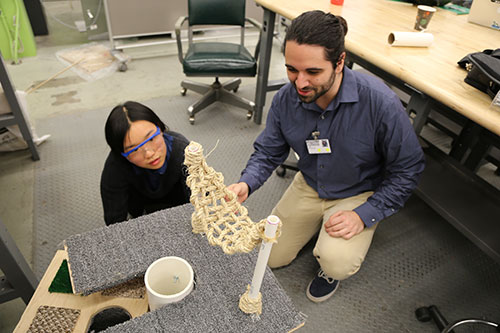PROVIDENCE, R.I. [Brown University] — When engineering student Sarah Dugan came to Brown, she had the luxury of knowing exactly what she wanted to study when she arrived. During high school, she had taken a class aimed at getting young students interested in engineering before they got to college.
“That class was pretty much why I became an engineer,” she said. “It’s where I first got involved and interested.”
Now in her junior year, Dugan has made sure to return that favor.
Along with fellow Brown undergrad Christine Herrmann and graduate student Jonathan Estrada, Dugan served as a teaching assistant for a high school class offered jointly by the University’s School of Engineering and the Lincoln School, a private, all-girls school in Providence. The class, taught at Brown by Brown faculty and students, introduces key engineering concepts and gives students access to tools and equipment in the Brown Design Workshop, a maker space in the School of Engineering.
Like the class that first inspired Dugan, this one is an effort to give students — in this case young women specifically — a taste of what college-level engineering is all about.
The partnership between Lincoln and Brown that spurred the class started last year, when engineering professors Iris Bahar and Clyde Briant, along with Kathy Takayama, former executive director of the Sheridan Center, approached Lincoln School head Suzanne Fogarty with the idea.
“We were thinking of a way to address this idea of getting girls involved in engineering in a non-intimidating way that would get them really excited,” Bahar said.
Typically, there’s not much engineering taught at the high school level, Bahar says. So the only way to get a sense of college-level engineering would be for a high school student to sit in on a college class, which can be a bit intimidating.
“What we wanted to do with this class was to tailor it for high school students,” Bahar said. “They work alongside students they already know, but they also get to come to Brown and get an idea of what it’s like to actually take a college-level course.”
Estrada, a fifth-year graduate student in solid mechanics, was the lead instructor for this year’s class and designed much of the curriculum. The course focused on mechanics — how stresses and forces act on structures. There was also a bit of material science to help the students understand how different types of materials react to being stretched or compressed.

Those lessons focused on the mathematical underpinnings of the concepts, and were reinforced by hands-on activities in the Brown Design Workshop. There, the students got to work with 3-D printers, laser cutters and a variety of other tools.
Ten Lincoln students signed up for this year’s class (the program’s second) which met once a week for three hours over the past 14 weeks. Last week, the students gathered in the Barus and Holley building to show off some of their projects to parents, Lincoln administrators and Brown faculty members.
For Caroline Morrow, a senior at Lincoln, the opportunity the class offered to apply classroom concepts to actually build things made the strongest impression. “Getting hands-on experience and getting to use the woodworking and metalworking tools was definitely my favorite part of this,” she said.
Lily Martin, a Lincoln sophomore, said the class was a chance to expand beyond her comfort zone.
“I’ve always liked science and math, but I never thought of myself as that good at them — especially science,” she said. “So I took this course to challenge myself and see if I could do it. I really ended up enjoying myself.”
And just as the class that Dugan took inspired her to study engineering, this class may create new engineers of its own. Haley Gomes, a Lincoln sophomore, was particularly inspired by lectures the students heard from Brown professors who work in biomedical engineering.
“I found that really interesting,” she said. “That’s a possibility for me.”
That’s really the point of the class — to keep the door open to engineering as a career path for these students. The class’s organizers hope that the program and ones like it might help to increase the pipeline of women entering engineering fields. Despite some progress in recent decades, women still tend to be underrepresented in STEM fields nationwide. That’s a problem that Estrada hoped to address, but his motivation for participating in the program was also personal.
“I have a younger sister who’s also an engineer,” he said. “We went to the same high school, and I know that she had way more barriers than I did. I thought that was a sin, and I wanted to try to do something about it if I could. This was a great opportunity to do that.”
It was also rewarding, Estrada said, to work with a class of talented young women.
“One of the best parts about teaching a class is seeing the growth of the students during the semester,” Estrada said. “It’s such a privilege to work with such great students. They’re going to be stars in whatever they choose to do.”